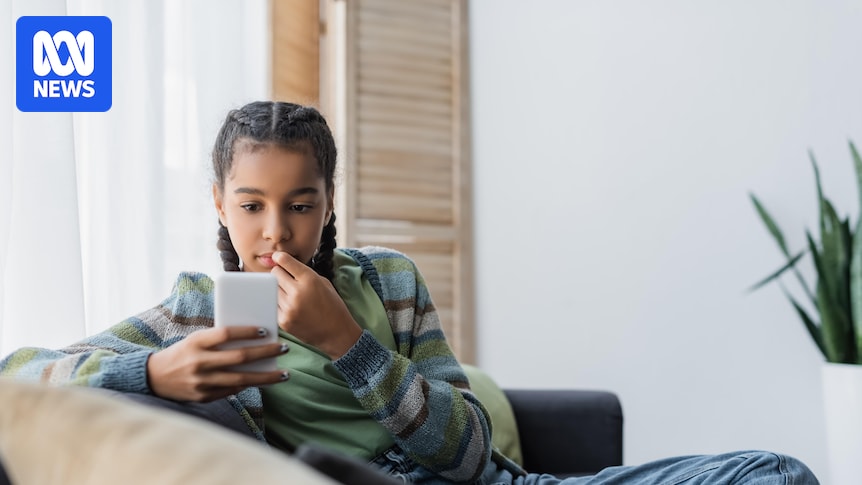Tilly is a “pretty strict” parent when it comes to screen time, electronic devices and social media.
Despite this, she says YouTube has caused issues in the home she shares with her husband and young son and daughter in Geelong, on Wadawurrung country.
About a year ago, her son accidentally used the regular YouTube app — instead of YouTube Kids — on their TV. As a result, he saw a preview for a horror film.
What teens think about YouTube ban
“He is still talking about [it] and being frightened and wanting to come into our bed,” says Tilly, who asked us not to use her full name for privacy reasons.
While the family does not post on social media, she is relieved to now be able to say, “and the government also said that you guys won’t be allowed to have it until you’re 16”.
But, Tilly says “the struggle is real” when it comes to managing screen time and social media use.
With the social media ban for under-16s set to come into effect later this year, experts share ways to effectively manage YouTube use in preparation.
How is YouTube affected by the social media ban?
The federal government’s social media ban for under-16s is set to come into effect on December 10.
After some back and forth, the government says it will include YouTube.
Kids will still be able to access the site’s content, but they will not be able to have an account.
Without one, they will be unable to view age-restricted content, leave comments or upload their own videos.
YouTube Kids is exempt because accounts cannot upload content or comment on videos.
Practical ways to help reduce use
Behaviour support practitioner Anne Dobson works with children through the NDIS, and says “boundaries need to be set in anything”.
A former teacher, she advises parents to support kids to understand and access “appropriate content”, which might look like transitioning from a YouTube account to a YouTube Kids profile.
Ms Dobson says setting clear time limits on screen time and internet access can also help. Parental controls can be set up on some wi-fi routers and devices.
Justin Coulson says “parents don’t need to do high-tech things to be across what’s going on with their kids”. (Supplied)
Parenting expert and father to six, Justin Coulson says, “the first thing that I would be doing is having the kids sign out of YouTube [on any accounts they have]”.
Beyond that, it comes down to monitoring and supervising, says Dr Coulson — who holds a PhD in psychology.
He advises being in the same room, making sure a device screen is facing into the room and keeping devices out of bedrooms and bathrooms.
“These are basic things. They’re not high-tech things.”
How to talk to your kids about the social media ban
Dr Coulson recommends using the three E’s of effective discipline — explain, explore and empower — to investigate how children are feeling about the upcoming changes to social media use.
“We need to explain where we’re coming from and help them recognise that their perspective is just one … we want to explain by providing really clear rationale.”
As a parent or guardian, he says to explore your child’s perspective, with “empower” meaning “we work on a solution together”.
“If they make a decision that is inconsistent with our values, the framework or rules that we’re trying to work within, we explain that.
“Ideally, our children will come up with a solution that they can feel good about that meets with our expectations.”
Carol Markie-Dadds says it is important that parents and carers start having discussions about the social media changes now. (Supplied: Triple P)
Dr Coulson says: “The government is doing every family a favour with this legislation … parents can literally say ‘I agree with it but it’s not actually me, it’s the government.'”
Carol Markie-Dadds is the country director of Triple P International, which delivers education and support for parents. She says it is best to have these conversations as soon as possible.
It is likely to be most challenging for those teenagers who have or had social media accounts, she says.
Frustration and disappointment may come up and she recommends making time “to process those emotions with our children and find out what it is that they think they’re missing out on as a result of the change”.
“Are there other ways in which we can provide a solution for them to meet the need?”
Why your behaviour is also important
Ms Dobson says if you are setting boundaries for the children in a household, the adults ought to have some, too.
When your child sees distressing content online
“That needs to be a commitment for the whole family … parents need to model what those boundaries look like”.
Ms Markie-Dadds acknowledges that it can be hard for parents to be good role models, as they can struggle with time away from devices too.
She says this could look like no-go zones for devices in the home (such as the dinner table) and keeping devices out of bedrooms.
“Having a really good routine about when and where we use devices and when and where we don’t.”
She says each family will need to come up with a plan that suits their individual needs.

